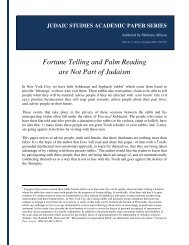Clarifying 70 Years of Whitewashing and ... - Shelomo Alfassa
Clarifying 70 Years of Whitewashing and ... - Shelomo Alfassa
Clarifying 70 Years of Whitewashing and ... - Shelomo Alfassa
Create successful ePaper yourself
Turn your PDF publications into a flip-book with our unique Google optimized e-Paper software.
Page | 14<br />
way from cold, malnutrition <strong>and</strong> beatings. They were placed in tobacco warehouses <strong>and</strong> in the last week<br />
<strong>of</strong> March they were locked inside freight trains as human cattle for the dreaded voyage to the port <strong>of</strong> Lom.<br />
One account tells how a train stopped by a labor camp, where early in the morning Jewish slave workers<br />
awoke to what sounded like the “wailing <strong>of</strong> caged birds.” A witness told that he saw a white-bearded old<br />
Jew, a Sephardic elder who was sentenced to death, crying: “No vos spantes, hermanos, la salvacion<br />
viene!” 84 [Have no fear, brothers, salvation is coming!] On that dark day <strong>of</strong> March 11, 1943 other Jews<br />
were rounded up <strong>and</strong> taken prisoner: 186 from Pirot in Yugolslavia; 3,500 from Skopje; 550 from Shtip;<br />
<strong>and</strong> 3,100 85 from Monastir (aka Bitola). 86<br />
The Jewish community <strong>of</strong> Monastir, 87 historically the largest Jewish community in Macedonia, was<br />
deported. 88 The terror started at 2am when <strong>of</strong>ficials gathered at police headquarters across Macedonia. 89<br />
The Bulgarian military established a blockade around the city to prevent escapes. At dawn members <strong>of</strong><br />
the KEV– Komisarstvo za Evreiskite Vaprosi (Bulgarian “Commissariat for Jewish Affairs”), 90 which had<br />
been established to institute anti-Jewish legislation in Bulgaria, broke into Jewish homes <strong>and</strong> hauled out<br />
their inhabitants. The Jewish quarter <strong>of</strong> Monastir 91 was divided into ten parts, with each assigned a<br />
contingent <strong>of</strong> police <strong>of</strong>ficers <strong>and</strong> soldiers. Once the Jews <strong>of</strong> Monastir were locked into ghettos, their<br />
84 Tamir. 194<br />
85 Mark Cohen in his extraordinary book (Last Century <strong>of</strong> a Sephardic Community: The Jews <strong>of</strong> Monastir, 1839-1943.<br />
Foundation for the Advancement <strong>of</strong> Sephardic Studies <strong>and</strong> Culture, New York, 2003.) details the name <strong>and</strong> occupation <strong>of</strong> every<br />
single victim from Monastir. 198-250<br />
86 All counted, some 7,315 Macedonian Jews put to death. See: P<strong>and</strong>evska, Maria. “The Rescue <strong>of</strong> the Jews <strong>of</strong> Macedonia (1941-<br />
1943): Options <strong>and</strong> Opportunities.” in Rozen, Minna. (ed.) The Last Ottoman Century <strong>and</strong> Beyond: The Jews in Turkey <strong>and</strong> the<br />
Balkans 1808-1945. 2 Vols. Tel Aviv:Goldstein-Goren Diaspora Research Center, Tel Aviv Univ., 2005. II:257<br />
87 This community was up almost exclusively <strong>of</strong> Judeo-Spanish speaking Jews who, in their historic allegiance to Turkey,<br />
continued to call their city ‘Monastir,’ the name it bore during centuries <strong>of</strong> Ottoman rule, even though since 1913 it was known as<br />
Bitola.<br />
88 In the year prior to the deportation, the Bulgarian government had dem<strong>and</strong>ed that all Jewish households h<strong>and</strong> over 20 percent<br />
<strong>of</strong> the value <strong>of</strong> all assets, including property, furniture, cash, <strong>and</strong> household items. Committees were established to assess the<br />
value <strong>of</strong> the Jews’ property. The possessions <strong>of</strong> those who did not have the money to pay the tax were sold at auction. The<br />
Bulgarians collected photos <strong>of</strong> all registered Jews <strong>and</strong> if one had no photo then the photo would be taken by a commissioned<br />
photographer hired by the Bulgarian government. (Cohen 173 - These photos <strong>and</strong> registration books are in the custody <strong>of</strong> Yad<br />
Vashem) All <strong>of</strong> these degrading, restrictive measures halted normal Jewish life in Monastir, even before the deportations. Zamila<br />
Kolonomos, a local Jewish woman, lived through these years <strong>of</strong> occupation in Monastir. She recalled, “Ansina la vida si truko i<br />
no avia mas ni enkontros, ni fiestar, ni bodas, ni aligrias” [Thus life was so greatly changed <strong>and</strong> there were no more gettogethers,<br />
no festivals, no weddings, no celebrations]. (USHMM Website “The Holocaust In Macedonia: Deportation Of<br />
Monastir Jewry” which quotes: Cohen, Mark. Last Century <strong>of</strong> a Sephardic Community: The Jews <strong>of</strong> Monastir, 1839-1943.<br />
Foundation for the Advancement <strong>of</strong> Sephardic Studies <strong>and</strong> Culture, New York, 2003.)<br />
89 See Cohen. 176-177 for full accounting <strong>of</strong> this process<br />
90 The aims <strong>of</strong> the Commissariat were to implement <strong>and</strong> enforce the anti-Jewish legislation (removal <strong>of</strong> their basic rights,<br />
imposition <strong>of</strong> economic <strong>and</strong> social restrictions, liquidation <strong>of</strong> businesses, confiscation <strong>of</strong> property <strong>and</strong> imposition <strong>of</strong> penalties,<br />
including the establishment <strong>of</strong> the concentration camp). In regards to economic affairs <strong>and</strong> the recruitment <strong>of</strong> men for the forced<br />
labor battalions, the KEV was assisted by the police force <strong>and</strong> other government institutions. The main purpose <strong>of</strong> the<br />
Commissariat was to prepare the deportations <strong>of</strong> Bulgarian Jewry <strong>and</strong> to provide aid to, <strong>and</strong> coordinate with, the Germans. (Yad<br />
Vashem Website: ‘Monastir During the Holocaust’).<br />
91 The occupations <strong>of</strong> the Jews <strong>of</strong> Monastir can be shown from a report <strong>of</strong> 1940: There were 80 shop assistants, 63 unskilled men,<br />
<strong>70</strong> porters, 57 cobblers, 54 vegetable vendors, 43 used clothing men, 43 merchants, 42 daily workers, 34 peddlers, 29 bakers <strong>and</strong><br />
flour merchants, 29 beggars, 26 assistant tailors, 24 small grocers, 22 butchers, 21 domestic servants, 17 tinsmiths, 16 poultry<br />
dealers, 14 fruit growers, 14 tanners, 11 café owners, 10 carters, 9 money changers, 9 clerks, 8 vegetable growers, 8 milkmen, 8<br />
rabbis, 8 sanitation workers, 7 students, 6 glaziers, 6 commercial agents, 6 barbers, 5 metal workers, 4 owners <strong>of</strong> small<br />
restaurants, 4 coke-men, 4 exporters, 3 physicians (not local), 3 tailors, 3 inn owners, 2 carpenters, 2 firefighters, 1 decorator, 1<br />
lawyer (not local), 1 dentist (not local) <strong>and</strong> 1 engineer (not local). Oren, Uri. A Town Called Monastir. Dror Publications, Tel<br />
Aviv, 1971. 179<br />
Judaic Studies Academic Paper Series / Library <strong>of</strong> Congress ISSN No. 2156-0390 © <strong>Shelomo</strong> <strong>Alfassa</strong> (shelomo@alfassa.com)



